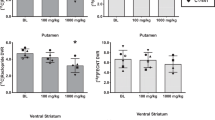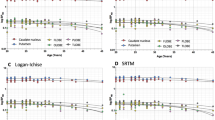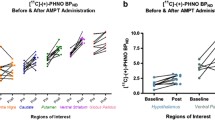Abstract
Rationale: Several positron emission tomography (PET) studies have shown that radioligand binding to D2-like dopamine receptors competes with endogenous dopamine. Objective: The purpose of this PET study was to examine the effect of amphetamine and reserpine on D1-like dopamine receptor binding. Methods: Three Cynomolgus monkeys were examined with the radioligands [11C]SCH 23390 or [11C]NNC 112 at baseline condition and after pretreatment with amphetamine (2 mg/kg IV). The B/F values (binding potential) in the striatum and the neocortex were calculated at transient equilibrium. In two monkeys, the effect of the long-lasting dopamine depletion after reserpine (1 mg/kg IV) was followed by a repeated Scatchard procedure in up to 77 days after drug administration. The Scatchard analysis was based on two PET measurements with high and low specific radioactivity and allowed the calculation of D1-like dopamine receptor density (Bmax) and apparent affinity (KD app). Results: The effect of amphetamine on the B/F values was between –14 and 6%. These changes can be considered as within the range of the test-retest reliability. Thus, there was no evident effect of amphetamine-induced dopamine release on D1-like dopamine receptor binding. Five hours after reserpine administration, there was no change in Bmax or KD app. At 3, 23, and 28 days after reserpine administration, the Scatchard analyses indicated a 13–20% reduction in Bmax without any evident change in KD app in both the striatum and the neocortex. Conclusions: The lack of evident effects of amphetamine and reserpine on D1-like dopamine receptor binding is markedly different from the 20% amphetamine-induced decrease and 50% reserpine-induced increase that has been consistently reported for D2-like dopamine receptor binding. The data indicated that D1-like dopamine receptor occupancy of endogenous dopamine is low at physiological condition. It is thus unlikely that D1-like dopamine receptor radioligands can be used to measure changes in the concentration of endogenous dopamine.
Similar content being viewed by others
Author information
Authors and Affiliations
Additional information
Received: 8 March 1999 / Final version: 12 May 1999
Rights and permissions
About this article
Cite this article
Chou, YH., Karlsson, P., Halldin, C. et al. A PET study of D1-like dopamine receptor ligand binding. Psychopharmacology 146, 220–227 (1999). https://doi.org/10.1007/s002130051110
Issue Date:
DOI: https://doi.org/10.1007/s002130051110




